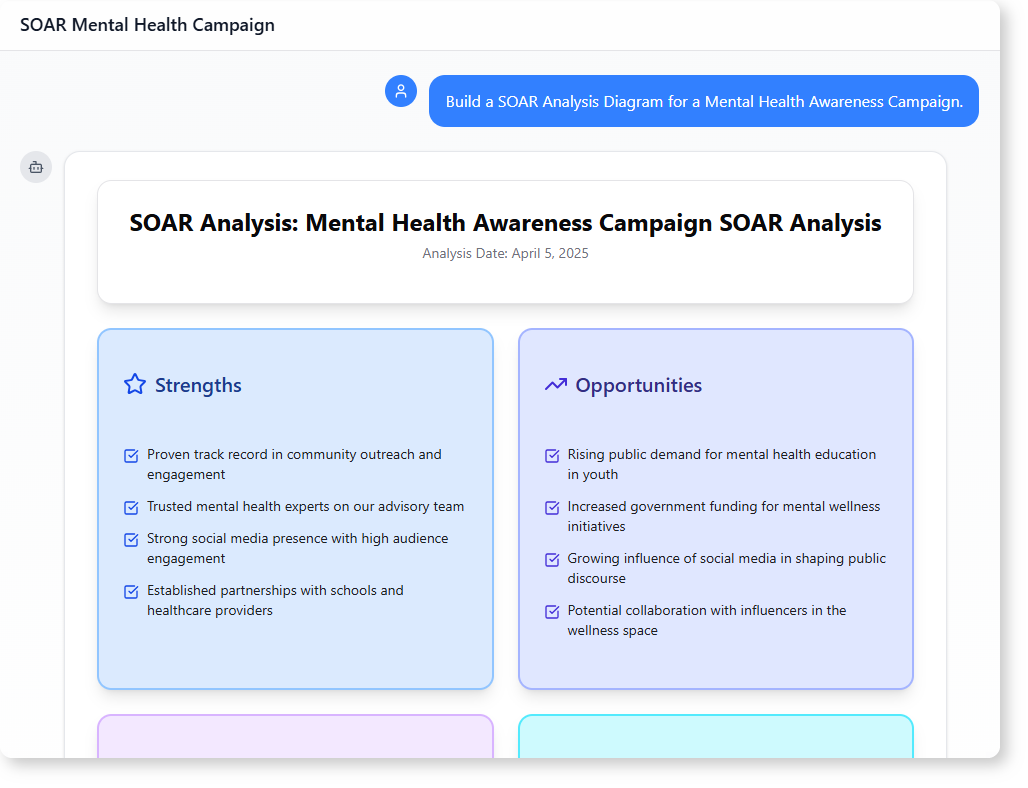Now Reading: How to Build a Mental Health Campaign Strategy with AI-Powered Modeling Software
-
01
How to Build a Mental Health Campaign Strategy with AI-Powered Modeling Software
How to Build a Mental Health Campaign Strategy with AI-Powered Modeling Software
How a Mental Health Campaign Used AI-Powered Modeling to Build Strategy
A team planning a mental health awareness campaign approached the right question: How do we make this initiative both meaningful and measurable?
They didn’t start by writing a 10-page proposal. Instead, they used an AI-powered modeling tool to build a SOAR Analysis—turning abstract ideas into clear, actionable strategy.
This isn’t just about diagrams. It’s about seeing the big picture through structured thinking. The result? A clear roadmap showing where the team stands, what it can do, and where it hopes to go.

What the User Was Trying to Achieve
The user was a nonprofit strategist leading a mental health campaign aimed at youth and schools. Their goal was to create a campaign that felt authentic, impactful, and data-driven.
They had existing experience in community outreach and social media—but wanted to ensure their strategy was built on solid, objective insights. They needed to answer:
- What are our current strengths?
- Where are we missing opportunities?
- What are our long-term ambitions?
- How do we measure success?
Rather than guess or rely on gut instincts, they turned to an AI-powered modeling software to generate a structured SOAR Analysis. This approach helped them move from ideas to a clear, visual strategy.
Step-by-Step Journey with the AI Chatbot
The process was simple and direct. Here’s exactly how it unfolded:
-
The user began by asking: ‘Build a SOAR Analysis Diagram for a Mental Health Awareness Campaign.’
The AI responded with a comprehensive SOAR Analysis, structured into four clear sections—Strengths, Opportunities, Aspirations, and Results.
-
After reviewing the initial structure, the user asked: ‘Generate a summary that highlights the strategic direction indicated by the SOAR Analysis Diagram.’
The AI returned a concise, high-level interpretation of the campaign’s strategic path, showing how each element connects to real-world impact.
The entire interaction took less than 5 minutes. No technical setup. No prior modeling knowledge required.
What the AI-Powered Modeling Software Delivered
The output wasn’t just a diagram. It was a strategic foundation.
Strengths
The team identified several key advantages:
- Proven track record in community outreach
- Trusted mental health experts on advisory boards
- Strong social media presence with engaged audiences
- Existing partnerships with schools and healthcare providers
These weren’t just perks—they were real assets that could be leveraged.
Opportunities
The AI highlighted areas where the campaign could grow:
- Increasing public demand for mental health education in youth
- New government funding for wellness programs
- The growing influence of social media in public conversations
- Potential partnerships with wellness influencers
These weren’t just possibilities. They were actionable entry points.
Aspirations
The team set ambitious but realistic goals:
- Launch a nationwide mental health awareness movement
- Normalize conversations about emotional well-being
- Empower 1 million people with accessible mental health resources
- Build a sustainable advocacy platform
These goals gave the campaign clarity and purpose.
Results (Measurable Outcomes)
The AI defined specific, trackable outcomes:
- Reach 5 million people by year-end
- Increase social media engagement by 200% in six months
- Launch five new mental health support tools or guides
- Achieve 90% positive sentiment in public feedback
These weren’t vague promises. They provided clear benchmarks to measure progress.
Why This Matters for Mental Health Campaigns
Traditional planning often starts with assumptions. With AI-powered modeling software, teams can shift from guesswork to grounded strategy.
This approach is especially useful when:
- You’re starting a new initiative with limited data
- You need to align stakeholders around shared vision
- You want to ensure your strategy reflects both current realities and future goals
The SOAR diagram doesn’t just show what’s possible. It shows what’s realistic, what’s valuable, and what’s worth investing in.
Is This the Right Tool for Your Project?
If your team is working on a campaign that involves strategy, impact, or long-term planning—this kind of structured analysis can be a game changer.
AI-powered modeling software isn’t about replacing human judgment. It’s about helping teams see connections they might miss when thinking alone.
It turns abstract ideas into visual, actionable frameworks. And in the context of mental health, where empathy and clarity go hand-in-hand, this can be especially powerful.
Frequently Asked Questions
Q: Can I use AI-powered modeling to understand a mental health campaign strategy?
A: Yes. The AI-powered modeling software helps structure strategic thinking by organizing insights into a clear SOAR framework—Strengths, Opportunities, Aspirations, and Results.
Q: Does this tool support mental health-specific strategies?
A: While the tool doesn’t have a mental health mode, it can generate a SOAR Analysis for any campaign. When used with a mental health campaign prompt, it produces relevant, context-aware insights.
Q: How does the AI interpret campaign goals?
A: The AI uses pattern recognition to identify strategic themes and translate them into measurable outcomes. It doesn’t create content—it helps organize existing knowledge into a coherent, actionable format.
Q: Is this suitable for non-technical teams?
A: Absolutely. The tool works with anyone who can describe a project or campaign clearly. No modeling background is required.
Ready to map out your mental health campaign strategy? Give our AI-powered modeling software a try at Visual Paradigm’s AI Chatbot today!
